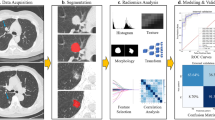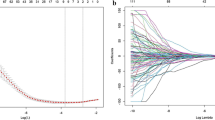Abstract
Purpose
Molecularly targeted therapy has revolutionized the therapeutic landscape and is emerging as the first-line treatment option for ALK-rearranged non-small-cell lung cancer (NSCLC). In this study, the highly informative and robust biomarkers based on pre-treatment CT images and clinicopathologic features will be developed and validated to predict the prognosis for ALK-inhibitor therapy in NSCLC patients.
Methods
A total of 161 ALK-positive NSCLC patients treated with ALK inhibitors were retrospectively collected as training, validation and test sets from multi-center institutions. Cox proportional hazard regression (CPH) penalized by LASSO and random survival forest (RSF) coupled with recursive feature elimination (RFE) were used for radiomics and clinical features identification and model construction. An overlapping post-processing method was extra added to training process to investigate the stronger biomarker on the whole set.
Results
123 of the collected cases progressed after a median follow-up of 15.5 months (IQR, 8.3–25.3). The T and M staging, pericardial effusion, age and ALK inhibitor-alectinib were determined as significant predictors in the survival analysis. Furthermore, we visualized the finally retained 4 radiomics feature. The RSF models built from overlapping-processed clinical and radiomics features respectively reached the maximum C-index of 0.68 and 0.75,but the combination of them,radioclinical signature, improved the score to 0.78. The model on the validation and external test datasets yielded the C-index of 0.73 and 0.79, with the iAUC of 0.76 and 0.83, the IBS of 0.119 and 0.112.
Conclusion
With respect to a simple selection strategy of overlapping optimal radiomics and clinical features from different survival models may promote better progression-free survival(PFS) prediction than conventional survival analysis, which provides a potential method for guiding personalized pre-treatment options of NSCLC.





Similar content being viewed by others
Availability of data and materials
The datasets used and/or analyzed during the current study are available from the corresponding author on reasonable request.
Abbreviations
- PFS:
-
Progression-free survival
- ALK:
-
Anaplastic lymphoma kinase
- NSCLC:
-
Non-small-cell lung cancer
- CPH:
-
Cox proportional hazard regression method
- RFE:
-
Recursive feature elimination
- RSF:
-
Random survival forest
- C-index:
-
Concordance index
- iAUC:
-
Integrated area under the curve
- IBS:
-
Integrated brier score
References
Atagi S et al (2016) Erlotinib for Japanese patients with activating EGFR mutation-positive non-small-cell lung cancer: combined analyses from two Phase II studies. Future Oncol 12(18):2117–2126. https://doi.org/10.2217/fon-2016-0163
Choe J et al (2021) CT radiomics-based prediction of anaplastic lymphoma kinase and epidermal growth factor receptor mutations in lung adenocarcinoma. Eur J Radiol 139:109710. https://doi.org/10.1016/j.ejrad.2021.109710
Dietrich S et al (2016) Random Survival Forest in practice: a method for modelling complex metabolomics data in time to event analysis. Int J Epidemiol 45(5):1406–1420. https://doi.org/10.1093/ije/dyw145
Dou TH et al (2018) Peritumoral radiomics features predict distant metastasis in locally advanced NSCLC. PLoS One 13(11):e0206108. https://doi.org/10.1371/journal.pone.0206108
Efron B (1977) The efficiency of Cox’s likelihood function for censored data. J Am Stat Assoc 72(359):557–565. https://doi.org/10.1080/01621459.1977.10480613
Graf E et al (1999) Assessment and comparison of prognostic classification schemes for survival data. Stat Med 18(17–18):2529–2545. https://doi.org/10.1002/(sici)1097-0258(19990915/30)18:17/18%3c2529::aid-sim274%3e3.0.co;2-5
Gainor JF et al (2013) ALK rearrangements are mutually exclusive with mutations in EGFR or KRAS: an analysis of 1,683 patients with non-small cell lung cancer. Clin Cancer Res 19(15):4273–4281. https://doi.org/10.1158/1078-0432.CCR-13-0318
Hung H, Chiang CT (2009) Estimation methods for time-dependent AUC models with survival data. Can J Stat 38:8–26. https://doi.org/10.1002/cjs.10046
Hanley JA (2018) Individually-matched etiologic studies: classical estimators made new again. Eur J Epidemiol 33(10):897–907. https://doi.org/10.1007/s10654-018-0434-4
Huang Y et al (2018) The prognostic impact of decreased pretreatment haemoglobin level on the survival of patients with lung cancer: a systematic review and meta-analysis. BMC Cancer 18(1):1235. https://doi.org/10.1186/s12885-018-5136-5
Hou D et al (2021) Association of anaplastic lymphoma kinase variants and alterations with ensartinib response duration in non-small cell lung cancer. Thorac Cancer 12(17):2388–2399. https://doi.org/10.1111/1759-7714.14083
Isaka T et al (2021) Effect of epidermal growth factor receptor gene mutation on the prognosis of pathological stage II-IIIA (8th edition TNM classification) primary lung cancer after curative surgery. Lung Cancer 162:128–134. https://doi.org/10.1016/j.lungcan.2021.11.002
Kwak EL et al (2010) Anaplastic lymphoma kinase inhibition in non-small-cell lung cancer. N Engl J Med 363(18):1693–1703. https://doi.org/10.1056/NEJMoa1006448
Kato R et al (2017) Prognostic impact of minimal pericardial effusion in patients with advanced non-small-cell lung cancer. Clin Lung Cancer 18(6):e449–e455. https://doi.org/10.1016/j.cllc.2017.05.011
Karami G et al (2021) Predicting overall survival time in glioblastoma patients using gradient boosting machines algorithm and recursive feature elimination technique. Cancers (Basel) 13(19):4976. https://doi.org/10.3390/cancers13194976
Karayama M et al (2021) Association of the geriatric nutritional risk index with the survival of patients with non-small cell lung cancer after nivolumab therapy. J Immunother 45(2):125–131. https://doi.org/10.1097/CJI.0000000000000396
Li H et al (2020) CT-based radiomic signature as a prognostic factor in stage IV ALK-positive non-small-cell lung cancer treated with TKI crizotinib: a proof-of-concept study. Front Oncol 10:57. https://doi.org/10.3389/fonc.2020.00057
Li Y et al (2020) Influence of feature calculating parameters on the reproducibility of CT radiomic features: a thoracic phantom study. Quant Imaging Med Surg 10(9):1775–1785. https://doi.org/10.21037/qims-19-921
Moreira AL, Thornton RH (2012) Personalized medicine for non-small-cell lung cancer: implications of recent advances in tissue acquisition for molecular and histologic testing. Clin Lung Cancer 13(5):334–339. https://doi.org/10.1016/j.cllc.2012.01.004
Ou SH, Zell JA (2008) Validation study of the proposed IASLC staging revisions of the T4 and M non-small cell lung cancer descriptors using data from 23,583 patients in the California Cancer Registry. J Thorac Oncol 3(3):216–227. https://doi.org/10.1097/JTO.0b013e318164545d
Peters S et al (2017) Alectinib versus crizotinib in untreated ALK-positive non-small-cell lung cancer. N Engl J Med 377(9):829–838. https://doi.org/10.1056/NEJMoa1704795
Pölsterl S (2020) Scikit-Survival: A library for time-to-event analysis built on top of scikit-Learn. J Mach Learn Res 21(212):1–6
Solomon BJ et al (2014) First-line crizotinib versus chemotherapy in ALK-positive lung cancer. N Engl J Med 371(23):2167–2177. https://doi.org/10.1056/NEJMoa1408440
Soufi M, Arimura H, Nagami N (2018) Identification of optimal mother wavelets in survival prediction of lung cancer patients using wavelet decomposition-based radiomic features. Med Phys 45(11):5116–5128. https://doi.org/10.1002/mp.13202
Song L et al (2020) Clinical, conventional CT and radiomic feature-based machine learning models for predicting ALK rearrangement status in lung adenocarcinoma patients. Front Oncol 10:369. https://doi.org/10.3389/fonc.2020.00369
Song Z et al (2021) The deep learning model combining CT image and clinicopathological information for predicting ALK fusion status and response to ALK-TKI therapy in non-small cell lung cancer patients. Eur J Nucl Med Mol Imaging 48(2):361–371. https://doi.org/10.1007/s00259-020-04986-6
Tang X et al (2021) Machine learning-based CT radiomics analysis for prognostic prediction in metastatic non-small cell lung cancer patients with EGFR-T790M mutation receiving third-generation EGFR-TKI osimertinib treatment. Front Oncol 11:719919. https://doi.org/10.3389/fonc.2021.719919
Taylor M et al (2022) Preoperative anemia is associated with worse long-term Survival after lung cancer resection: a multicenter cohort study of 5,029 patients. J Cardiothorac Vasc Anesth 36(5):1373–1379. https://doi.org/10.1053/j.jvca.2021.08.029
Uno H et al (2007) Evaluating prediction rules for t-year survivors with censored regression models. J Am Stat Assoc 102(478):527–537. https://doi.org/10.1198/016214507000000149
van Griethuysen JJM et al (2017) Computational radiomics system to decode the radiographic phenotype. Cancer Res 77(21):e104–e107. https://doi.org/10.1158/0008-5472.CAN-17-0339
Zhu X et al (2018) Radiomic signature as a diagnostic factor for histologic subtype classification of non-small cell lung cancer. Eur Radiol 28(7):2772–2778. https://doi.org/10.1007/s00330-017-5221-1
Zwanenburg A et al (2020) The Image Biomarker Standardization initiative: standardized quantitative radiomics for high-throughput image-based phenotyping. Radiology 295(2):328–338. https://doi.org/10.1148/radiol.2020191145
Acknowledgements
The authors would like to thank other 19 centers for the external data, including Tonglu First people’s hospital, Xiaoshan First people’s hospital, Huzhou Central hospital, the First hospital of Jiaxing, Jiangshan people’s hospital, the first people’s hospital of Hangzhou Linan district, Ningbo medical center Linhuili hospital, Ningbo Zhenjiang district hospital of Chinese Medicine, Pinghu First people’s hospital, Ruian people’s hospital, Shaoxing people’s hospital, Zhejiang Quhua hospital, Zhuji people’s hospital, Xixi hospital of Hangzhou, the Fourth affiliated hospital Zhejiang university school of medicine, the First affiliated hospital of USTC, 903RD hospital of PLA, Zhejiang provincial hospital of traditional chinese medicine, Shulan hospital. The authors would like to thank Wei Shen for advice and support in the conceptualization.
Funding
This work was supported by Medical Health Science and Technology Project of Zhejiang Province (2021KY094, 2022RC114).
Author information
Authors and Affiliations
Contributions
LS and ZS contributed to the study conception and conducted the study. Material preparation, data collection and analysis were performed by JS, FL, JY, XZ, NL and BZ. The first draft of the manuscript was written by FL and JS and edited by CL and LS. All authors read and approved the final manuscript, agreed to its submission, and had full access to the original data.
Corresponding authors
Ethics declarations
Conflict of interest
The authors declare no conflict of interest.
Ethics approval and consent to participate
This study was performed in line with the principles of the Declaration of Helsinki. Approval was granted by the institutional ethics committee of Zhejiang Cancer Hospital (approval code IRB-2022-111, 8 March 2022).
Consent for publish
Not applicable.
Additional information
Publisher's Note
Springer Nature remains neutral with regard to jurisdictional claims in published maps and institutional affiliations.
Supplementary Information
Below is the link to the electronic supplementary material.
Rights and permissions
Springer Nature or its licensor (e.g. a society or other partner) holds exclusive rights to this article under a publishing agreement with the author(s) or other rightsholder(s); author self-archiving of the accepted manuscript version of this article is solely governed by the terms of such publishing agreement and applicable law.
About this article
Cite this article
Sun, J., Li, F., Yang, J. et al. Pretherapy investigations using highly robust visualized biomarkers from CT imaging by multiple machine-learning techniques toward its prognosis prediction for ALK-inhibitor therapy in NSCLC: a feasibility study. J Cancer Res Clin Oncol 149, 7341–7353 (2023). https://doi.org/10.1007/s00432-023-04615-3
Received:
Accepted:
Published:
Issue Date:
DOI: https://doi.org/10.1007/s00432-023-04615-3




